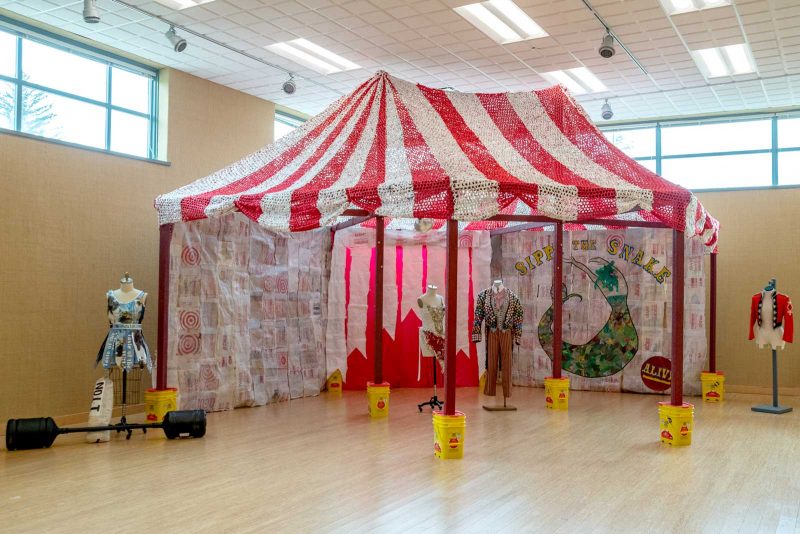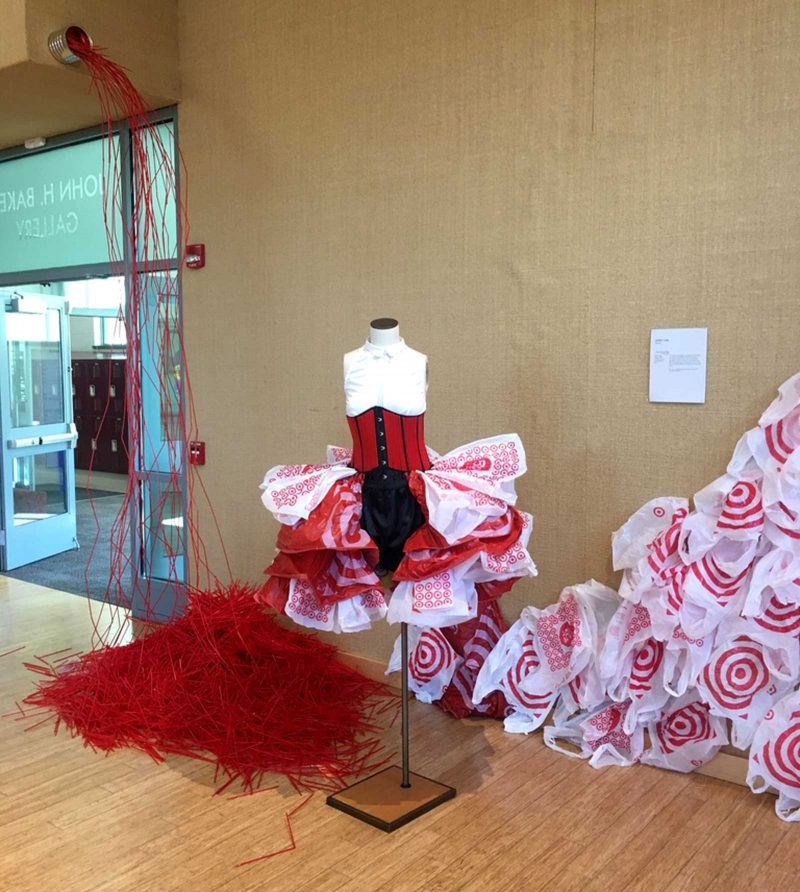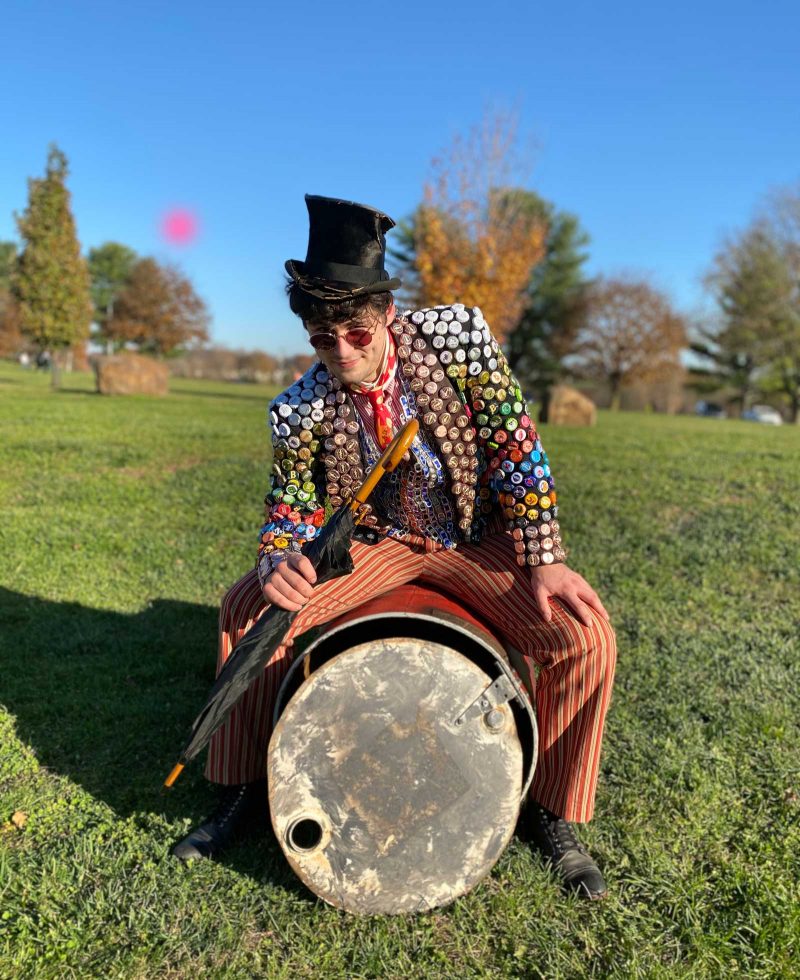Land Acknowledgement statement: This article was written in Philadelphia, which sits on part of the traditional territory of the Lenni-Lenape, called “Lenapehoking.” I acknowledge the Lenni-Lenape as the original people of this land and their continuing relationship with their territory. And I affirm the aspiration of the great Lenape Chief Tamanend, that there be harmony between the indigenous people of this land and the descendants of the immigrants to this land, “as long as the rivers and creeks flow, and the sun, moon, and stars shine.” (shortened from the land acknowledgement statement on the tribal website)

Warning: there are two parts to the review. The first one is fictional, the second is real. They can be read independently in any order.
1. Philadelphia April, 2062: A Premonitory Review of ‘Carnival of Ruin’
I just teleported myself back to my South Philly apartment from West Chester University where I saw an exhibition titled Carnival of Ruin created by Constance Case, Gretchen Studlien-Webb and Maria Urrutia, three youthful faculty members in the Dance and Theatre Department.
The gallery exhibited a dazzling array of costumes and props made of 40-year old materials — post-consumer waste from grocery plastic bags and straws to large drinking water containers and bottle caps. The hand-made costumes are part of a larger production, an outdoor, site-specific performance scheduled for the month of May.
The costumes are designed to fit several actors who will perform a farcical, burlesque, phantasmagorical fable about sustainability and preservation.
The gallery experience caused me to reminisce about “ruin,” and about the 40-year old materials and goods that in part caused it. Younger readers might have a harder time to relate, but Philadelphia used to be a city of brick row homes with an exceptional collection of Colonial, Federal and Victorian houses and buildings. In 2015, UNESCO recognized Philadelphia as a world heritage city partly because of its unique and historic architecture.
Gazing toward the North/East through the window of my 162nd floor apartment building, I clearly see Front street (6th street until the late 2020s) and the banks of the wide Delaware River.
The view from my window is a clear reminder of the catastrophic and irreversible impact that global warming and the rise of sea levels have had on Philadelphia, on both coasts of the US, and the rest of the world. A giant historical marker bobbing above the surface of the water now marks the location where once stood Gloria Dei (or Olde Swedes’) Church, the oldest building in town, completed in 1700.
The Society Hill Towers used to have 32 floors. Luckily developers have been able to add 63 floors that amply compensated for the 13 lowest original floors which are now under water. Luckily technology has made possible the consolidation and resuscitation of existing skyscrapers made of reinforced concrete now in flooded areas. New York City which survived, is now called the Venice of North America, in remembrance of the lost city of Venice, Italy.
Older Philadelphians might remember taking visitors to see the Liberty Bell at the corner of 6th and Market streets. It still feels odd to see the bell on display inside Lemon Hill Mansion in East Fairmount Park. But we are all grateful for the technical prowess of the US Army Corps of Engineers for also moving to higher grounds the cherished symbols of our country: Independence Hall and Carpenters’ Hall, now sitting next to the Please Touch Museum in West Fairmount Park.
Pulling myself out of my reveries, I will tell you happily that the three West Chester University Faculty members confessed how challenging and how long it took to find enough plastic material to proceed with their project, which they undertook as a cautionary tale about taking your environment for granted. Again, younger readers might need a refresher. Plastic used to be a way of life, an indispensable commodity for more than half a century. The profusion of plastic bags, barely altered, in the exhibit, made me think of how much, just a few decades ago, plastic conditioned our daily life. Plastic was part of the daily landscape. It littered sidewalks. Public trash cans, often overflowing with plastic containers were found everywhere. Shreds of plastic, ripped apart by mechanical vehicles that adults drove themselves, were commonly seen hanging from trees adjacent to highways and or along train tracks.
Our creation of plastics, which are petrochemical byproducts, and our excessive reliance on fossil fuel products caused great — and lasting — toxicity to earth’s air.
Think about our dependence on nutritive oxygen, constantly pumped into our indoor environment and ATAV (Air Travel Automated Vehicles). We cannot live without them. Incidentally, the United States was the first country to outlaw plastic in 2031 under the Harris administration followed by a worldwide ban in 2035.

One piece in the exhibition, “Target Lady”, immediately triggered nostalgia in me. Target Lady is a cabaret outfit/character. The skirt is made with dozens of fluffed up Target store plastic bags. Target was a well-known national retail chain in the first decades of the 21st century. Back then, its white and red logo resembling an old fashioned archery target was emblematic of consumer culture. The bustier is made of plastic vertical red Collins straws. I thought the straws had been simply glued but Constance Case, whose expertise is in costume design was quick to point out that they have been painstakingly stitched together. Plastic straws were ubiquitous with drinks. In the 2010s, you could hardly order a beverage out without getting a straw.
Carnival of Ruin is a time capsule of the kind of past that we would like to forget and perhaps have forgotten although its consequences have forever impacted us. Under a technicolor, whimsical, veneer hides the shocking truth about a society addicted to fossil fuels and for far too long in denial of its irreversible ravages.
2. Philadelphia, April 2021: A Real Review of ‘Carnival of Ruin’
My one-hour commute from Center City to West Chester University was in retrospect a premonition of the exhibition that I was about to see in the art gallery there. The journey was a visual catalogue of plastics’ pollution embedded in the entrenched economic, social and racial disparities faced by this country. From Center City streets lined with shops and imposing office buildings, through rundown neighborhoods, and into the bucolic landscape along parts of West Chester Pike; finally, to quaint downtown West Chester, it was clear who were the communities most impacted by pollution, in particular pollution caused by plastic bags.
The gallery showcased the performers’ costumes (more than a dozen) and the stage props such as a large circus-like tent, all entirely made of post-consumer waste.
An impressive quantity of plastic shopping bags, but also bottle openers, pull tabs and fabric — some donated (like men’s ties) — make up the raw material for these costumes. Some materials seem to require little transformation and are therefore immediately recognizable.
This is the case with “Target Girl” whose skirt is made from bags from the namesake big box store or “Sippy the Snake’s” coat composed of dozens of cascading men’s ties. This last coat could literally be cut for a fashion collection except for the fact, I was told, that it weighs a lot and is quite challenging to wear.
The virtuoso-crocheted ceiling of the large circus tent is another technical tour de force. It is entirely made of crocheted plastic bags. For that, 2500 bags were cut into strips. The strips were then attached together to create long plastic strings and then crocheted.
Creative craftmanship is on display everywhere. Time is not of the essence as each piece required long hours of repetitive and perhaps meditative manual labor. We learn for instance that the crocheted roof required 160 human hours.
The arduous and long process needed to achieve this variety of costumes and props is not evident at first sight. The vibrant colors and overall playfulness of the costumes are deceptive. Exhibition labels, as well as photographs and videos posted online reveal however the scope of the laborious project, which started more than four years ago and required an unflinching collaboration from the three professors, undoubtedly put to test this past year by Covid restrictions.
Besides describing the materials used and how they were processed, exhibition labels also reveal the core social and environmental message of the project: to bring awareness to the unstainable amount of trash our consumerist society produces and its impact on the environment.

The symbolic meaning of the characters that belong to these costumes clearly lays out the environmental challenges faced by the planet. Each character embodies a concept, or rather a facet of the uncontrollable tragedy that has been unfolding for a few decades.
Each character description also comes with a simple tip, a practical easy action to remember and implement. For “The Mermaid,” who personifies the death of the ocean, the tip reads “Use aluminum cans whenever possible as aluminum is the most valuable recyclable metal.”
Not all characters are villains. A couple of them exhibit traits of hope or resilience in the face of the destructive consumerist society. “Queen Bee” and “The Attendants” for example reflect the positive action that communities are capable of implementing when change is necessary.
I was curious to know how the world of performing arts had been impacted by the issues raised by the exhibition. Gretchen Studlien-Webb mentioned the example of workout clothes worn daily by dancers. Toxic chemicals linked to cancer have been found in sportswear manufactured by well-known brands. Studien-Webb learned it the hard way herself after designing a dress out of VHS videotape and discovering that the toxic metal on its surface is harmful when it starts to disintegrate. It is for this reason that VHS tapes cannot just be dumped into landfills.
The Carnival of Ruin show’s environmentally conscious message coincides with Philadelphia’s long-awaited ban in the Fall on the approximately one billion plastic bags used each year in the city. An information campaign on the ban will start this summer, but the city will only start to fully enforce the law in Spring, 2022. Philadelphia is far behind other major cities on passing a ban on disposable bags. The successful attempts to delay the ban by the state legislature are a somber reminder that it might take years for Pennsylvania to join California, Delaware, Hawaii, New York and Oregon on banning the distribution of plastic bags.
It should be said that the message of Carnival of Ruin never feels moralizing. The intriguing craftsmanship, vivid outfits and jovial characters confer on the show its overall carnivalesque liveliness and playfulness.
Next, Carnival of Ruin is going on tour. An outdoor performance is scheduled May 29th in East Goshen Township Park in West Chester, PA. Then the experience will be complete. Actors will be performing in nature as the show was intended, in the very nature that the costumes’ material harm, degrade and pollute. And if you wonder what will happen to the material. Most of it can be upcycled. Pieces will be donated to ECO Plastics Products of Delaware, partners of Carnival of Ruin, a non-profit company that specializes in recycling plastic to make consumer goods such as benches, tables and fences. https://www.ecoplasticproducts.org/
For information, tickets and future events, check out the ‘Carnival of Ruin‘ website.









